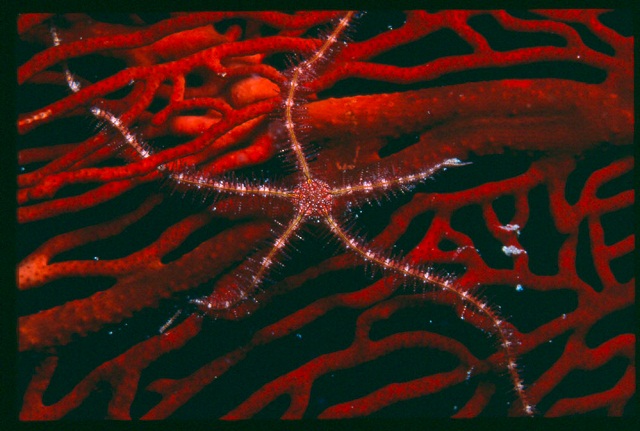
Sarah Bedolfe
Gorgonians, like sea fans and sea whips, are perfectly shaped to filter plankton from the current for food.
Featuring one amazing marine animal per week.
Sea fans belong to the phylum Cnidaria, just like corals and jellies do, but they are most closely related to soft corals and to sea pens. They are part of a group known as gorgonians, members of the Order Gorgonacea.

A big red gorgonian sea fan accompanied by fish and crinoids, or feather stars. Photo courtesy of MacGillivray Freeman Films.
They are sessile or immobile; colonies grow attached to a hard surface. They can be found in many different ocean habitats, but are most common in the tropics. Like corals, many gorgonians have symbiotic algae known as zooxanthellae, which provide the sea fan with extra energy by performing photosynthesis. Other species, especially those that live in deep waters where sunlight doesn’t reach, survive without them, just getting food by filter feeding.

Little polyps protrude from red branches. Photo by Mohammed Al Momany, NOAA Photo Library via Flickr, Creative Commons License.
Other forms of gorgonians exist, such as sea whips, and encrusting gorgonians, but the most familiar varieties are sea fans. They can form vast structures up to several meters wide, yet can be very thin, and they come in all sorts of spectacular colors.
Along each branch of the colony are countless tiny individual polyps, each with eight tentacles that pull plankton from the current. Just like the polyps of stony corals and of sea anemones – and all cnidarians, for that matter – the a sea fan’s little polyps’ tentacles can sting their minute prey. The fans’ wide, branched shape is perfect for filtering as much water as possible as it passes by. Gorgonians, like other filter feeders, therefore are important for helping keep the ocean’s water clean.

Pygmy seahorses are virtually impossible to spot due to their great camouflage. Photo by Caparbio via Wikimedia Commons, Creative Commons License.
They also are important habitats for other critters. If you examine a gorgonian closely, you can find all kinds of animals hiding among the delicate branches, from fish to sea stars to pygmy seahorses. As you can see in the photos, these animals are often perfectly adapted for living upon a specific sea fan and they can sometimes be nearly invisible on their resident sea fan because they are so perfectly camouflaged.
Because of their beauty, gorgonians are sometimes collected and sold as decorations. Since some species are threatened due to overexploitation by this market, such as the pink sea fan which is listed as vulnerable, it is best to use caution or to altogether avoid purchasing such animals for décor.

Yellow polyps stand out on the purple branches. Photo by Ed Bierman via Flickr, Creative Commons License.

This gorgonian is home to a brittle star. Photo courtesy of MacGillivray Freeman Films.

Gorgonians can grow to a massive width and height, while being only inches thick. Photo by Matt Kieffer via Flickr, Creative Commons License.

A sea slug crawls among the branches. Photo courtesy of MacGillivray Freeman Films.

A fish, perfectly camouflaged for life on this sea fan. Photo courtesy of MacGillivray Freeman Films.







